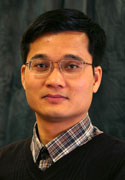Minh Do was part of the first generation of Vietnamese students who went abroad to study as the Southeast Asian country began to liberalize its economy and society in the early 1990s. Do, who was born a year before war with the United States ended in 1975, says his youthful interest in mathematics coincided with his country’s growing commitment to education.
“I was fascinated by math and it is also very suited for a poor, developing country like Vietnam because you don’t need to have a lot of investment; it’s really just paper and pencil,” Do said. “I was in this gifted class and was trained to solve math problems. So I went through a lot of competitions, and ultimately trained on the national team.”
Eventually, Do and his team competed at the International Mathematical Olympiad in Sweden, where he won a Silver Medal.
“I saw that the living standards there were far more than what we had in Vietnam,” Do said. “It opened up my perspective. And I saw the importance of engineering, not just solving problems, but how to make things too.
“I was 18-years-old at that point and I was just getting ready to go to college. It helped to shape my perspective. I said ‘well, I want to be able to go into engineering, to make products, and really have an impact on people’s lives and mathematics is not sufficient to do that.’ We started to be able to read foreign magazines and I got really drawn to engineering.”
Do won a scholarship from the Australian government that allowed him to earn an undergraduate degree in Computer Engineering from the University of Canberra. He then went to Switzerland to earn a Ph.D. in Communications Systems.
Do joined the faculty at Illinois in 2002. He is a member of Beckman’s Image Formation and Processing group and an Associate Professor in the Department of Electrical and Computer Engineering, with joint appointments at the Coordinated Science Laboratory and the Department of Bioengineering, in addition to Beckman.
As a younger faculty member and researcher, Do has already won many honors, including a National Science Foundation CAREER Award, a Young Author Best Paper Award from the IEEE Signal Processing Society, and has been voted by his students to the Teachers Ranked as Excellent List.
When it comes to his research mission, Do remains true to the motivation that first steered him toward engineering as a young man back in Vietnam.
“I had read that the engineering disciplines involved innovation and how that changed people’s lives,” Do said. “So I thought ‘maybe I want to build something like computer systems or software.’”
And that is exactly what Do is doing these days as part of his research involving the broad topics of signal and image processing. His group’s research mission, as he writes, is to develop new “true” multidimensional tools — rather than the current, one-dimensional processing methods — that can capture geometrical structures that are usually the dominant feature in images and multidimensional data. Do believes future imaging systems have to be designed using an integrative approach that includes both image formation and high level image processing, as well as a variety of disciplines.
“It’s really a multiple frontier that we have to tackle to create this new technology and slowly bring it to everyday life,” he said.
In order to do that, Do develops multidimensional signal processing tools for imaging applications, using the physics of sensor data, computer algorithms, and the psychology of perception. He seeks to integrate those tools in advancing imaging from the level of physics to how data is collected and processed, and how images are received by the end-user.
“My research is about making the digital image better,” Do said. “The digital image could be from a digital camera, or it could be something we see through an HD-TV, or that a doctor sees for diagnostics. My work is about all the computational tools: the understanding of mathematics, coupled with physics and computer science to make these images, for whatever purpose.”
Do has several research areas involving signal processing, but has a special interest in collaborations with Beckman colleagues in advancing imaging modalities such as magnetic resonance, optical, and spectroscopic, especially as those methods apply to biomedicine.
“I’m collaborating with Stephen Boppart, Zhi-Pei Liang, Gabriel Popescu, Rohit Bhargava, Bill O’Brien, Michael Oelze, and Doug Jones, all from different modalities,” Do said.
“My contribution is to learn the underlying computational problems and add my expertise to manipulate signals and images. So my research is about understanding how to model the real world in the discrete domain (where computers work), and how to make the discrete construction faithfully capture what is out there in the real world. It would add speed and accuracy.”
Do said working with collaborators like those he mentioned at Beckman offers him a unique opportunity.
“That really energizes me to work with these people and because we can really tackle unique and challenging fundamental problems,” Do said. “And we have fantastic students, really the best of the world. The luxury and the benefit of being here at the Beckman and the University of Illinois is that these are the best students from all over the world coming here. They are able to learn from interdisciplinary research areas and make a strong impact in the field.”
